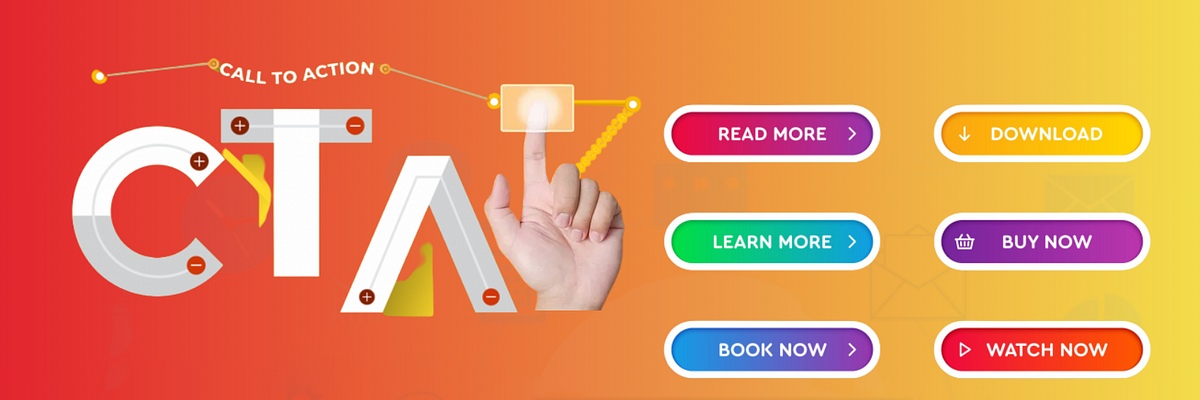How Utilising Calls to Action Can Drastically Improve Conversions.
Think back to a time when you’ve clicked on an advertisement or purchased something on a website – what was it that made you click?
Chances are it’s a combination of things:
Strong, Enticing Graphic Design
Text that speaks to your unique challenges, offers solutions, and leads to a successful outcome is a key element of effective calls to action (CTAs).
Now, let's delve into what CTAs are, their significance, and how they contribute to website conversion rate optimisation. Throughout this piece, we'll address these queries comprehensively, along with providing insights on enhancing your website's CTAs to elevate overall conversion rates.
What is a Call to Action (CTA)?
A call to action, or CTA as it’s better known, is a written prompt (often on a button) that features compelling copy designed to make you take a desired action. Businesses can use CTAs to entice a user to visit a webpage, to sign up for a newsletter, or for anything, really.
All CTAs will direct the potential user/customer to a landing page or provide some other interaction (such as a download).
Where can CTAs be Used?
There are myriad uses for CTAs. If you want someone to visit a page on your website or to access specific information, then chances are you’ll want a call to action.
CTA usage includes:
- On advertisements
- Within social posts
- On your website’s pages
- In emails
- On videos
- In audio (webinars/podcasts/radio, etc.)
Essentially, CTAs can be used anywhere that you want someone to take an action.
Why use CTAs on Your Website?
CTAs help to:
- Improve your conversion rate
- Drive traffic to your key webpages
- Boost click-through rates and prevent bouncing (leaving your website without taking an action)
The hard part of marketing is getting people onto your website. CTAs make it easier for the user to know where to click and what will happen once they do. They also help to streamline the user journey, creating an experience with less friction, organically improving conversion rates of a website.
A website without CTAs would be like a supermarket with no signs – finding what you want would be a nightmare!
What Makes a Good CTA?
Good CTAs are clear and relevant, aren’t too long and often use emotive language.
When planning your website, you should also plan where you’d like each page to link to.
For example, a relatively generic CTA route might look like Homepage > Product page > Contact Us page. It’s a logical user journey that will make sense to most people.
Along this journey should be relevant, logical CTAs to match. For example:
Homepage – [Discover our products], [How does this work?], [Learn about X product]
Product page – [Talk to our product experts], [Need help? Get in touch], [Accelerate your X – speak to us]
Contact Us page – [Fill out the form], [Get tailored support], [Speak to our friendly specialists]
Obviously, this will vary depending on your industry and unique circumstances, and the above examples are very vague by design, but you get the idea – CTAs can be used to guide a user through your website; they are a vehicle upon which your user travels through the funnel.
10 Ways You Improve Your Website CTAs
1. Make Your Copy Action Oriented
You’re writing a call to action – don’t forget your verbs!
- Secure your deal.
- Try it for free!
- Get yours today.
Get creative with your CTAs – experiment with a wide variety of verbs and see what works best for your audience.
2. Use Eye-Catching Colours
The colour you choose for CTAs matters. It needs to stand out against your website’s background colour, but mustn’t be too distracting.
Not sure what colour to use? We recommend A/B testing it! This is where you create two versions of a webpage and change a single variable. In this case, you’d make the buttons different colours and see which button converts better.
3. Shorter, the Better
CTAs shouldn’t be essays. Short, snappy and to the point – that’s what you want.
4. Use White Space
White space around your CTAs helps create a visual break, drawing the reader’s attention right to where you want it.
Extra white space works even better if your target audience are regularly visiting your website on mobile, as it adds extra tapping room for fingers.
5. Urgency is Important
Creating a sense of urgency can be really effective when writing CTAs:
- Today only: 50% off!
- 4 Spaces left – reserve now!
- Deal ends today!
6. Keep CTAs ‘Above the Fold’
The ‘fold’ is everything that you can see on the webpage before you scroll down. If you’ve got an important CTA on your page, you don’t want to make users scroll down before they find it.
Keep your main messaging and CTAs right at the top, ready to be clicked (more CTAs can be included further down to catch anyone who wasn’t ready to convert at the top).
7. Keep Your Font Legible and Clear
Clear fonts, good size.
Your CTA text should be large and easily read (but not too large, otherwise it looks spammy).
8. Avoid Overcrowding
Too many links or images will overcrowd a webpage. Keep it clear around your CTAs.
This helps them stand out and dramatically increases the chance that a user will click on your buttons. This is another good reason to make your CTA a nice bright colour that sticks out over your other images.
9. Use the 1st/2nd Person
Refer to the user directly:
- Start your free trial.
- Grow my business.
The 1st and 2nd person helps to subconsciously connect your audience to your products as you’re speaking directly to them. Always put your reader/listener at the centre of the story you’re telling.
10. Follow a Natural Progression
We read top to bottom, left to right.
This means that it makes logical sense for your CTA buttons to sit just below or to the right of your introductory text.
Once someone has read your body copy, they’ll naturally move onto the button. Put it on the left or at the top and the button will have no context. No context = less clicks.
Looking to Improve Your Digital Marketing Presence?
We are Perfected Media – a commercially-focused digital marketing agency based in London.
When we say, ‘commercially focused’, we mean it. We focus on data and facts rather than guesswork and hunches, helping deliver results in the form of tangible business growth, more leads and more sales for our clients.
If you’d like to join a list of growing businesses, don’t hesitate to get in touch with our team of lead generation specialists to discuss your marketing efforts.

